#more specifically greece and rome .
Text
today im thinking about malaria in ancient rome.
about the fact that P. falciparum (the most dangerous kind of malaria) was likely endemic at least from the 2nd century BC onward
that Galen said semitertian fevers (P. falciparum infections) were more common in Rome than anywhere else in the Roman Empire
that the most severe manifestations of P. falciparum (quotidian fevers + cerebral malaria) were most common in babies and young children, an epidemiological observation that indicates the transmission rate of P. falciparum was extremely high in Rome
that Quintus Serenus said there was no Latin word for semitertian fevers (they used a transliteration of the Greek, 'hemitritaeos') because "no one, i think, could have named it in our language and mothers would not have wanted to"
#working on my thesis gonna bring down the mood of the whole department#but i feel like i have to honor them#and the thing about malaria that fucks me up is P. falciparum has been around for tens of thousands of years#its not a disease of agriculture like smallpox or of sanitary issues that come with civilization like typhoid#it predates agriculture its been found in the bodies of mummies from ancient egypt and skeletons from ancient greece and rome#there are species-specific plasmodium parasites for gorrillas chimpanzees and humans#which to me indicates there was a plasmodium parasite for every now lost hominid#malaria is the strongest recent evolutionary pressure on the human genome#upwards of 30% of people in some parts of the world are heterozygous for sickle cell anemia#or heterozygous for SE asian ovalocytosis#thus it was more evolutionarily advantageous for 2-3% of all children to die#so about 30% of people could be protected from severe malaria#these mutations take a long time to evolve. parasites take a long time to evolve#there are people who mourned their infants tens of thousands of years ago in languages we will never know with rituals we will never see#and i cant do anything about any of that but i can keep going to the lab every day and trying my best to figure it out#because so many generations of humans stretching back to before we were human could not
27 notes
·
View notes
Text

i know this is just a blog theme based on ancient greece and op didnt have any bad intentions in mind but . maybe you shouldnt use something thats literally a well known far-right / nazi dogwhistle for your blog about history. it might raise some eyebrows. just a thought
#if you know who this is please dont harrass them im sure they didnt mean it this way#its just sad to me as a pole to see shit like this so often in ancient history spaces#more specifically greece and rome .#and educate yourself about dogwhistles and secret code like this. at least the basic things. especially if#- ww2 didnt affect your family personally. dont spread this ideology by being ignorant
17 notes
·
View notes
Text
Yes this is a Greek Mythology inspired podcast but I'm also a Classics major so of COURSE I'm gonna ides of March post on here too
#i focused more on greece than rome with my degree just based on interest#but i still gotta rep rome from time to time#specifically to stab julius caesar again#pines notes
3 notes
·
View notes
Text
every day I come online and see someone tag a 19th c painting with 'classical art' and it takes every ounce of will power not to turn into a snob about it
#not every oil painting is a classical painting !!#classical art was made in ancient greece & rome#what you're tagging are (most often) rococo; neoclassical & baroque styles#and then you have romanticism & realism#and our favourite impressionism#this was me bitchin about art periods#and yes there's more specific labels for periods such as early & high renaissance & manerism & all that#but just know that whenever you tag a boucher painting as 'classical art' my heart dies a lil
3 notes
·
View notes
Text
So I accidentally almost got into an argument on Twitter, and now I'm thinking about bad historical costuming tropes. Specifically, Action Hero Leather Pants.
See, I was light-heartedly pointing out the inaccuracies of the costumes in Black Sails, and someone came out of the woodwork to defend the show. The misunderstanding was that they thought I was dismissing the show just for its costumes, which I wasn't - I was simply pointing out that it can't entirely care about material history (meaning specifically physical objects/culture) if it treats its clothes like that.
But this person was slightly offended on behalf of their show - especially, quote, "And from a fan of OFMD, no less!" Which got me thinking - it's true! I can abide a lot more historical costuming inaccuracy from Our Flag than I can Black Sails or Vikings. And I don't think it's just because one has my blorbos in it. But really, when it comes down to it...
What is the difference between this and this?
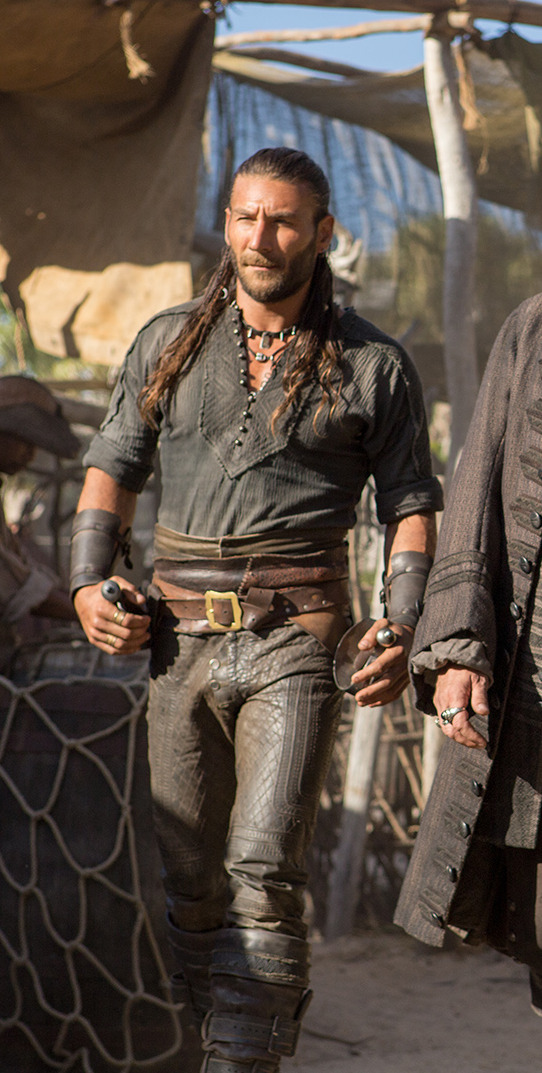
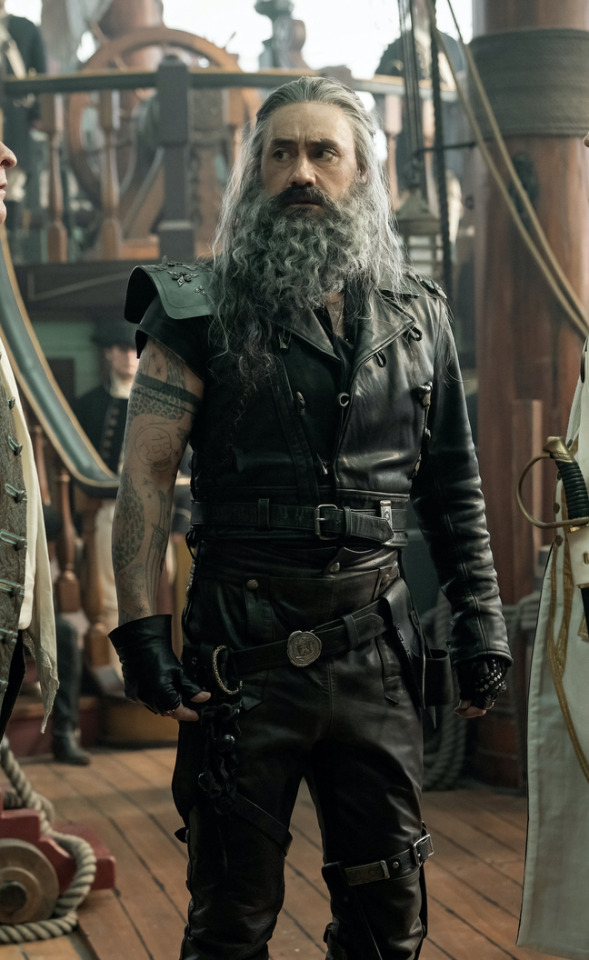
Here's the thing. Leather pants in period dramas isn't new. You've got your Vikings, Tudors, Outlander, Pirates of the Caribbean, Once Upon a Time, Will, The Musketeers, even Shakespeare in Love - they love to shove people in leather and call it a day. But where does this come from?

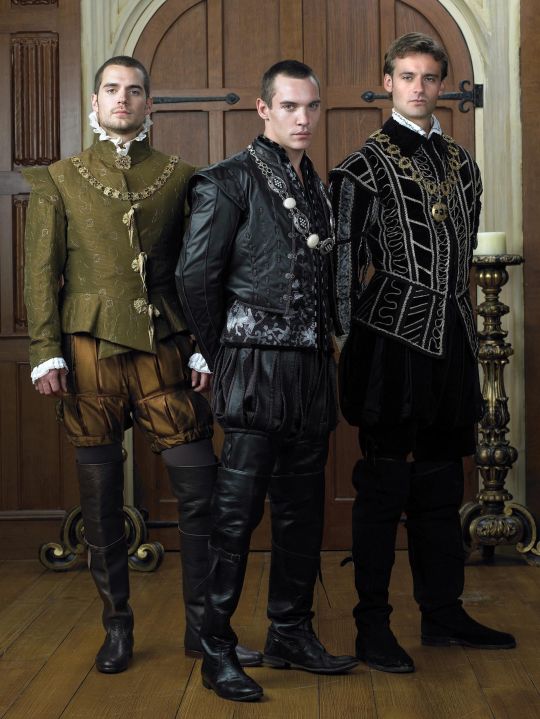


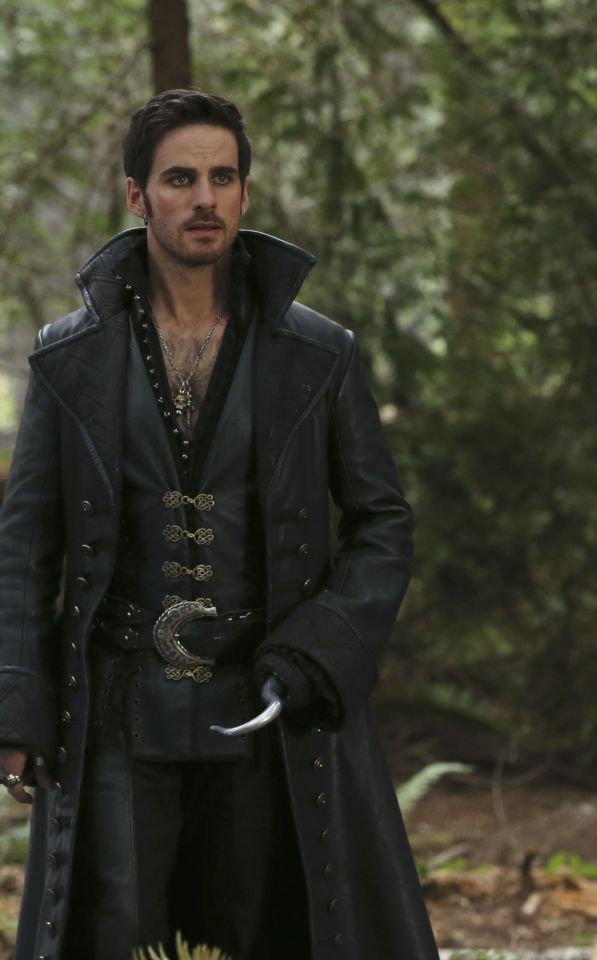

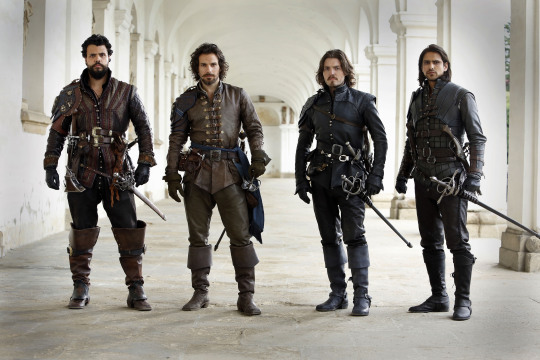

Obviously we have the modern connotations. Modern leather clothes developed in a few subcultures: cowboys drew on Native American clothing. (Allegedly. This is a little beyond my purview, I haven't seen any solid evidence, and it sounds like the kind of fact that people repeat a lot but is based on an assumption. I wouldn't know, though.) Leather was used in some WWI and II uniforms.
But the big boom came in the mid-C20th in motorcycle, punk/goth, and gay subcultures, all intertwined with each other and the above. Motorcyclists wear leather as practical protective gear, and it gets picked up by rock and punk artists as a symbol of counterculture, and transferred to movie designs. It gets wrapped up in gay and kink communities, with even more countercultural and taboo meanings. By the late C20th, leather has entered mainstream fashion, but it still carries those references to goths, punks, BDSM, and motorbike gangs, to James Dean, Marlon Brando, and Mick Jagger. This is whence we get our Spikes and Dave Listers in 1980s/90s media, bad boys and working-class punks.


And some of the above "historical" design choices clearly build on these meanings. William Shakespeare is dressed in a black leather doublet to evoke the swaggering bad boy artist heartthrob, probably down on his luck. So is Kit Marlowe.
But the associations get a little fuzzier after that. Hook, with his eyeliner and jewellery, sure. King Henry, yeah, I see it. It's hideously ahistorical, but sure. But what about Jamie and Will and Ragnar, in their browns and shabby, battle-ready chic? Well, here we get the other strain of Bad Period Drama Leather.
See, designers like to point to history, but it's just not true. Leather armour, especially in the western/European world, is very, very rare, and not just because it decays faster than metal. (Yes, even in ancient Greece/Rome, despite many articles claiming that as the start of the leather armour trend!) It simply wasn't used a lot, because it's frankly useless at defending the body compared to metal. Leather was used as a backing for some splint armour pieces, and for belts, sheathes, and buckles, but it simply wasn't worn like the costumes above. It's heavy, uncomfortable, and hard to repair - it's simply not practical for a garment when you have perfectly comfortable, insulating, and widely available linen, wool, and cotton!
As far as I can see, the real influence on leather in period dramas is fantasy. Fantasy media has proliferated the idea of leather armour as the lightweight choice for rangers, elves, and rogues, a natural, quiet, flexible material, less flashy or restrictive than metal. And it is cheaper for a costume department to make, and easier for an actor to wear on set. It's in Dungeons and Dragons and Lord of the Rings, King Arthur, Runescape, and World of Warcraft.


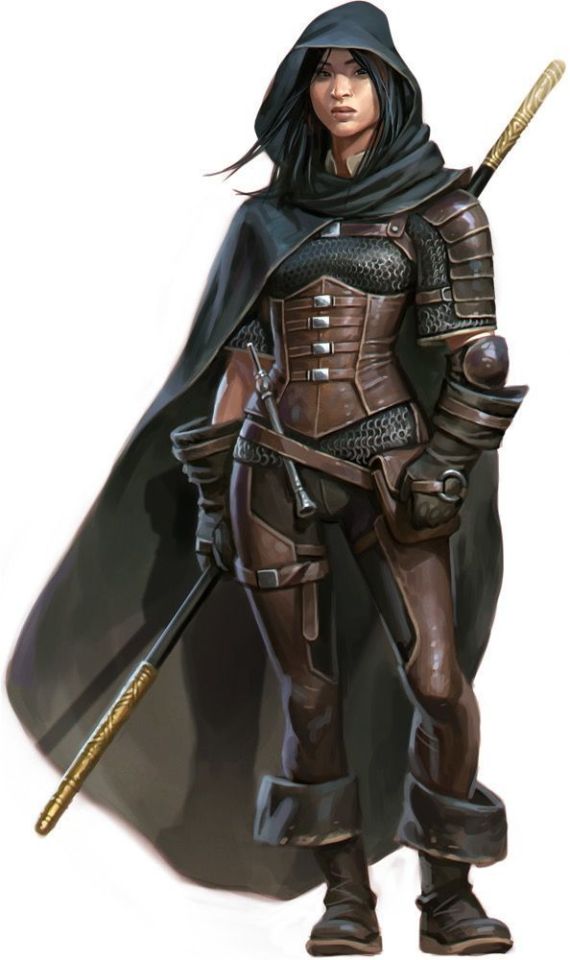
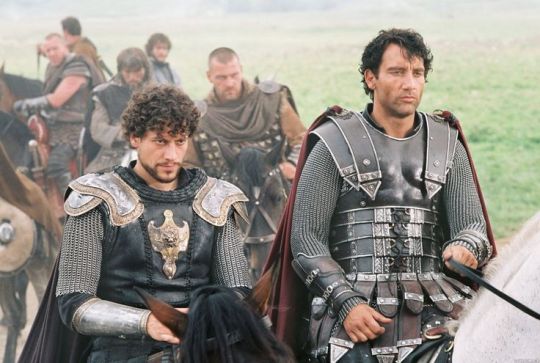

And I think this is how we get to characters like Ragnar and Vane. This idea of leather as practical gear and light armour, it's fantasy, but it has this lineage, behind which sits cowboy chaps and bomber/flight jackets. It's usually brown compared to the punk bad boy's black, less shiny, and more often piecemeal or decorated. In fact, there's a great distinction between the two Period Leather Modes within the same piece of media: Robin Hood (2006)! Compare the brooding, fascist-coded villain Guy of Gisborne with the shabby, bow-wielding, forest-dwelling Robin:

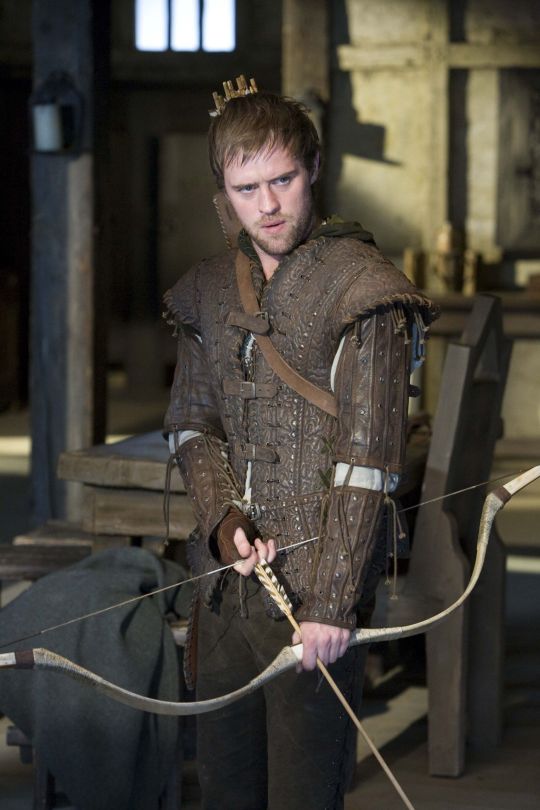
So, back to the original question: What's the difference between Charles Vane in Black Sails, and Edward Teach in Our Flag Means Death?
Simply put, it's intention. There is nothing intentional about Vane's leather in Black Sails. It's not the only leather in the show, and it only says what all shabby period leather says, relying on the same tropes as fantasy armour: he's a bad boy and a fighter in workaday leather, poor, flexible, and practical. None of these connotations are based in reality or history, and they've been done countless times before. It's boring design, neither historically accurate nor particularly creative, but much the same as all the other shabby chic fighters on our screens. He has a broad lineage in Lord of the Rings and Pirates of the Caribbean and such, but that's it.
In Our Flag, however, the lineage is much, much more intentional. Ed is a direct homage to Mad Max, the costuming in which is both practical (Max is an ex-cop and road warrior), and draws on punk and kink designs to evoke a counterculture gone mad to the point of social breakdown, exploiting the thrill of the taboo to frighten and titillate the audience.

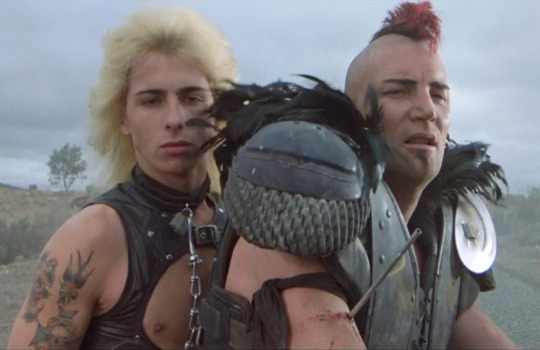
In particular, Ed is styled after Max in the second movie, having lost his family, been badly injured, and watched the world turn into an apocalypse. He's a broken man, withdrawn, violent, and deliberately cutting himself off from others to avoid getting hurt again. The plot of Mad Max 2 is him learning to open up and help others, making himself vulnerable to more loss, but more human in the process.

This ties directly into the themes of Our Flag - it's a deliberate intertext. Ed's emotional journey is also one from isolation and pain to vulnerability, community, and love. Mad Max (intentionally and unintentionally) explores themes of masculinity, violence, and power, while Max has become simplified in the popular imagination as a stoic, badass action hero rather than the more complex character he is, struggling with loss and humanity. Similarly, Our Flag explores masculinity, both textually (Stede is trying to build a less abusive pirate culture) and metatextually (the show champions complex, banal, and tender masculinities, especially when we're used to only seeing pirates in either gritty action movies or childish comedies).
Our Flag also draws on the specific countercultures of motorcycles, rockers, and gay/BDSM culture in its design and themes. Naturally, in such a queer show, one can't help but make the connection between leather pirates and leather daddies, and the design certainly nods at this, with its vests and studs. I always think about this guy, with his flat cap so reminiscient of gay leather fashions.

More overtly, though, Blackbeard and his crew are styled as both violent gangsters and countercultural rockstars. They rove the seas like a bikie gang, free and violent, and are seen as icons, bad boys and celebrities. Other pirates revere Blackbeard and wish they could be on his crew, while civilians are awed by his reputation, desperate for juicy, gory details.
This isn't all of why I like the costuming in Our Flag Means Death (especially season 1). Stede's outfits are by no means accurate, but they're a lot more accurate than most pirate media, and they're bright and colourful, with accurate and delightful silks, lace, velvets, and brocades, and lovely, puffy skirts on his jackets. Many of the Revenge crew wear recognisable sailor's trousers, and practical but bright, varied gear that easily conveys personality and flair. There is a surprising dedication to little details, like changing Ed's trousers to fall-fronts for a historical feel, Izzy's puffy sleeves, the handmade fringe on Lucius's red jacket, or the increasing absurdity of navy uniform cuffs between Nigel and Chauncey.
A really big one is the fact that they don't shy away from historical footwear! In almost every example above, we see the period drama's obsession with putting men in skinny jeans and bucket-top boots, but not only does Stede wear his little red-heeled shoes with stockings, but most of his crew, and the ordinary people of Barbados, wear low boots or pumps, and even rough, masculine characters like Pete wear knee breeches and bright colours. It's inaccurate, but at least it's a new kind of inaccuracy, that builds much more on actual historical fashions, and eschews the shortcuts of other, grittier period dramas in favour of colour and personality.
But also. At least it fucking says something with its leather.
#everyone say 'thank you togas' for not including a long tangent about evil rimmer in red dwarf 5x05#Our Flag Means Death#Togas does meta#and yes these principles DO fall apart slightly in s2 and i DON'T like those costumes as much#don't get me wrong they're fun and gorgeous - but generally a bit less deep and more inaccurate. so. :(#I'm not sure this really says anything new about Our Flag but I just needed to get my thoughts out#i hate hate hate Gritty Period Drama costumes they're so boring and so ugly and so wrong#god bless OFMD for using more than 3 muted colours and actually putting men in heels (and not as a shorthand for rich/foppish villainy) <3#looking at that Tudors still is insane like they really will go to any lengths to not make men feel like they've got bare legs XD#image descriptions in alt text#and yes i DID just sink about two hours into those so you'd better appreciate them
1K notes
·
View notes
Text
Okay something I wish people understood more is that folk religion and folklore is never static. It varies by region by year by storyteller. There is no Single True Canon in an oral folk tradition. Ancient Greek Religion for example was not one set thing, there is no one set version of “Greek Mythology” or Hellenic folk traditions that is correct. There are different cults that were worshipped in different regions and whose traditions changed over time, some of which had membership that was often mostly a political thing (i.e. most prominent political figures in Greece and Rome for several centuries were inducted into the Eleusinian mystery cult which worshipped Demeter and Kore) or just based in which cities worshipped which patron gods. Hesiod’s Theogeny, the Homeric Hymns, the Apollodorus, all of which are written records of tales from “Greek Mythology,” contradict each other in various ways. Most Greek and Roman plays and epics were written more in response to contemporary political situations than any adherence to a specific legend.
There is no single set canon to other folk traditions either. The body of Arthurian canon is also contradictory and was written by a variety of people across several cultures often shaped by individual political lenses.
This is Also true of the modern US equivalent of written folk tales: superhero comics canon. Written by dozens and hundreds of different people across decades responding to different sociopolitical circumstances and publishing priorities, inherently contradictory basically the whole way through.
#tagamemnon#folk traditions#dc comics#arthuriana#also marvel but I try not to care about marvel products any more#caitie speaks#ancient greek religion#hellenism#Caitie talks classics
183 notes
·
View notes
Text
Maggie’s pendants and good omens
Yes, you’ve read it right. This post is going to deal with some literal good omens, not just title drop! But first things first, let’s take a closer look at the topic of this analysis.


A toucan
The top necklace is a lovely design involving a crowned toucan — believed to be a messenger of gods able to travel between the spiritual and the physical world, often associated with rain and rainbow (a Christian symbol of divine love, grace, and mercy, a reminder of the covenant between God and humanity to spare the latter from future trials like the Flood) — encircled by a gold band (a symbol of infinity, eternal love and promise) spun by a small butterfly (a symbol of transformation, hope, and rebirth). All three symbols combined seem to deliver a divine message of hope for rebirth, possibly resurrection, and the eternal life. Very fitting in the context of the Second Coming.
The fact that toucans were revered by the native South Americans as rainbringers strengthens the symbolic meaning of another type of bird we can spot on Maggie’s clothes in the very first episode, as her character introduction — a swallow. Swallows flying low are also believed to be harbingers of rain and bad weather. If you see one close to Earth or a building, it means that there’s a storm — or a certain biblical tempest — on the horizon.

In Ancient Greece and Rome swallows were representing Aphrodite, goddess of love. In Christianity they were considered to be of God and symbolized hope, awakening, and revival of life as messengers of spring and protectors from winter colds. Also helped Jesus on the Cross — according to a Christian legend, a group of swallows was supposed to take out the thorns from the Crown of Thorns and alleviate His Passion on the Cross. Humans banding together in the name of good have been a big theme in the series ever since The Them made an appearance, and from what we already know about the unpublished Good Omens sequel, we can assume that Jesus is going to take the spotlight in the upcoming season.
Maggie definitely attracts sudden inexplicable weather changes, like a thunderstorm with weirdly localized lightning strikes or a sudden downpour. And we’re still waiting for some vavooming (and the following happy ending) to happen in S3.

A heart with an eye
Now, the more nuanced clue hidden in the bottom necklace. I know that some of us were trying to tackle the concept of Maggie’s eye in a heart pendant suggesting her Masonic connotations, but this symbol (or the Eye of Providence in general) isn’t strictly Masonic, it isn’t even limited only to Judeo-Christian art. And while it is used a lot in Christian iconography, we should focus on a very specific example of it already referenced in the show.
Buckle up, we’re making a parachute dive into S1.
It seems like our old friend, Agnes Nutter, still has our backs.

Prophecy 4020:
Let the wheel of fate turne, let harts enjoin, there are othere fyres than mine; when the whirl wynd whirls, reach oute one to another.

If you look closely at the bottom right corner of this frame, you will see that as an illustration for the above prophecy the production team chose a 1611 engraving titled The Minde should have a fixed Eye On Objects, that are plac’d on High first found in Gabriel Rollenhagen’s Nucleus emblematum selectissimorum.
In 1635 it was published in A Collection of Emblemes, Ancient and Moderne Quickened With Metrical Illustrations, both Morall and Divine, Etc by George Wither with the accompanying hymn:

A Heart, which bore the figure of an Eye
Wide open to the Sunne; by some, was us'd,
When in an Emblem, they would signifie
A Minde, which on Celestiall Matters mus'd:
Implying, by the same, that there is nought
Which in this lower Orbe, our Eyes can see,
So fit an Object for a manly thought,
As those things, which in Heav'n above us be.
God, gave Mankinde (above all other Creatures)
A lovely Forme, and upward-looking Eye,
(Among the rest of his peculiar Features)
That he might lift his Countenance on high:
And (having view'd the Beauty, which appeares
Within the outward Sights circumference)
That he might elevate above the Sphæres,
The piercing Eye, of his Intelligence.
Then, higher, and still higher strive to raise
His Contemplations Eyes, till they ascend
To gaine a glimpse of those eternall Rayes,
To which all undepraved Spirits tend.
For, 'tis the proper nature of the Minde
(Till fleshly Thoughts corrupt it) to despise
Those Lusts whereto the Body stands inclin'd;
And labour alwayes, upward to arise.
Some, therefore, thought those Goblins which appeare
To haunt old Graves and Tombes, are Soules of such,
Who to these loathsome places doomed were,
Because, they doted on the Flesh too much.
But, sure we are, well-minded Men shall goe
To live above, when others bide below.
And hey, guess what 4020, i.e., the number of the prophecy, symbolizes in Strong’s Concordance? Periergazomai, a Greek word meaning “to waste one's labor about something” — to meddle, going beyond proper boundaries (where a person doesn't belong); to fixate on what others are doing, instead of doing what the person himself is supposed to do.
It appears only once in the Bible:
2 Thessalonians 3:11: We hear that some among you are idle and disruptive. They are not busy; they are busybodies. Such people we command and urge in the Lord Jesus Christ to settle down and earn the food they eat. And as for you, brothers and sisters, never tire of doing what is good.
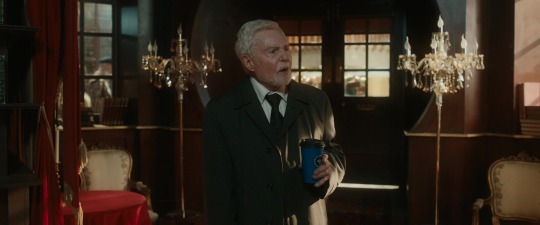
To make things slightly more interesting, in the Hebrew version of Strong’s Concordance 4020 has another meaning — migbaloth, meaning “twisted things, i.e. cords”. Which doesn’t make much sense until we read the actual passage:
Exodus 28:24 and two chains of pure gold, twisted like cords; and you shall attach the corded chains to the settings.
And compare it to the most recent post on the topic published directly by Word of God:

What if all these clues didn’t apply to Maggie and Nina, but Aziraphale and Crowley instead? What if Maggie served as a messenger — consciously or not — just like the toucan, delivering the prophecy to those who need it most?
“When the tempest comes and darkness and great storms, and the dead will leave their graves and walk the Earth once more and there will be great lamentations for the end is near, don’t lose hope, hold hands and look up.”

Basically what Aziraphale and Crowley already did when they performed the 25 Lazarii miracle, only with no interference from Gabriel this time around.
And, if both Strong’s Concordance and Maggie’s personal addition to her second pendant are to be believed, with a wedding band somehow involved in the process.
#everything has a meaning#the invisible and unbreakable line that joins Crowley and Aziraphale#two chains of pure gold twisted like cords#never tire of doing what is good#don’t lose hope#hold hands and look up#the good omens crew is unhinged#good omens props#good omens costumes#the nice and accurate prophecies of agnes nutter#agnes nutter#good omens#maggie service#good omens meta#good omens analysis#strong’s concordance#yuri is doing her thing#ineffable husbands#wedding bands
82 notes
·
View notes
Note
I love the way you write the headcanons about the First Years + Ortho going to the reader's world! Could you do the same with the Second Years, please?

Riddle Rosehearts
Favorite Country/City: He would love to go visit Stratford-Upon-Avon in England, as he is one to enjoy being in the city of one of the most famous playwrights and authors in history: William Shakespeare. Also, there is tea available at most shops, so he will still be able to follow the Queen of Hearts’ rules.
Favorite Cuisine/Dish: Again, his favorite dish is strawberry tarts, and they apparently originate in France as tarts were used to showcase the seasonal not-berries. That aside, he also does appreciate French cuisine as a whole.
Favorite Drink: Again, he enjoys tea, but I think he would like strawberry lemonade. More specifically, the strawberry lemonade from those restaurants that put those slices of strawberries into the drink.
Favorite Souvenir: A small Shakespeare bust that he can place on a bookshelf as a book holder.
Favorite Singers/Songs: He absolutely loves classical music, specifically from the Classical Era. He prefers the classics: Bach, Beethoven, Marianna Martines, etc. Favorite song would be Für Elise, by Ludwig van Beethoven.
Favorite Movie: The Phantom of the Opera, but the 1927 silent film version.
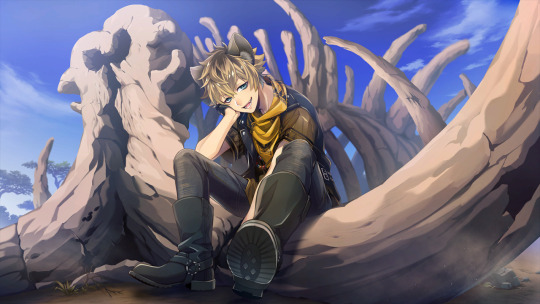
Ruggie Bucchi
Favorite Country/City: I originally was going to say that he would have liked Luxembourg because it’s one of the richest countries in the world, but I decided that would be too easy. I feel like he would love to go to Cairo in Egypt. It’s very rich in history and culture, and I’ve heard they have good food (someone confirm, plz).
Favorite Cuisine/Dish: His favorite food is donuts, and I looked it up and they apparently originate from either Ancient Greece/Rome or Medieval Arab chefs. That being said, either cuisines (Greek, Italian, or Middle Eastern) would be his favorite. He has a very diverse palate.
Favorite Drink: Depending on if he prefers coffee or tea, he would like either Mazboot or even Zjada coffee, or karkade (please correct me on any of this, I am not from the Middle East and have never been so if it’s incorrect you can tell me. Got this info from online).
Favorite Souvenir: A small, handmade pot that he found at one of the markets. He thought it looked interesting and thus purchased it. The vendor was really kind as well.
Favorite Singers/Songs: This is kind of hard, but AMERICAN HORROR SHOW by SNOW WIFE would be his favorite, meaning hyperpop would be his favorite genre. He gives me TikTok boy vibes for some reason, and he would also like most songs that popped up on his FYP.
Favorite Movie: Lion King, and I’m not trying to be funny. He just likes the “It’s not funny, Ed”, where Ed erupts even more into laughter. It makes him snicker a bit as well. Maybe I was trying to be funny.
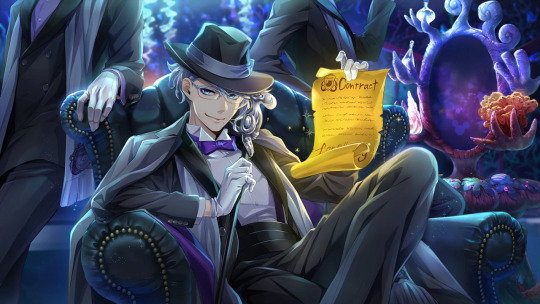
Azul Ashengrotto
Favorite Country/City: He would love the township of Cavendish in Prince Edward Island, Canada. It’s got the ocean, it’s got the small town vibes, and it inspired L.M. Montgomery’s fictional town of Avonlea in Anne of Green Gables. Speaking of, he would totally resonate with Anne because they both entered a society that they weren’t knowledgeable of the norms of.
Favorite Cuisine/Dish: Because he loves fried chicken, I would say his favorite cuisine is that of the Southern United States. You can’t go wrong with coleslaw, cornbread, green beans, mashed potatoes, and Southern hospitality.
Favorite Drink: Iced Tea, specifically from the Southern states as well. If we’re talking about cocktails, then Long Island Iced Tea would be his go-to. However, he prefers to drink at home because he doesn’t have to call anyone to pick him up.
Favorite Souvenir: It’s stated that he likes collecting coins, so yeah.
Favorite Singers/Songs: This man loves Elvis Presley’s music, and no one can fight me on this. He’s a bit of a hopeless romantic, so he loves either Heartbreak Hotel or Can’t Help Falling in Love is his favorite song.
Favorite Movie: Romeo and Juliet, the one starring Leonardo DiCaprio. The movie’s great, the actor not so much. He’s a bit of a hopeless romantic, as I stated before, so he would very much like a Romeo to his Juliet. Mans wants to be in a tower with a window sill and he wants someone to be standing below to talk to in a romantic way.
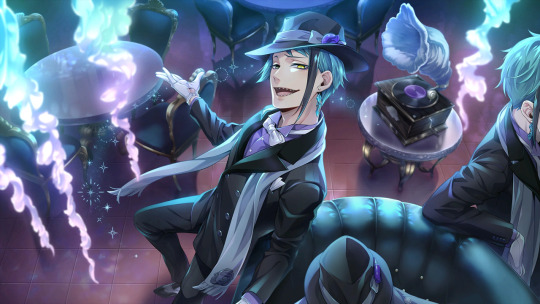
Jade Leech
Favorite Country/City: He loved going scuba diving in the Mariana Trench, and since the Trench is located between Hawaii and the Philippines, I think he would love staying in the Philippines. The city he favors would be Boracay, even though it’s in the middle of the Philippine Islands and a bit further from the East.
Favorite Cuisine/Dish: His favorite dish is octopus carpaccio, and it’s kind of obvious that it’s Italian. He does enjoy Italian cuisine as a whole as well. However, if we are taking the octopus components of the dish, then I believe he would also be a lover of Japanese cuisine.
Favorite Drink: It is recommended that with octopus carpaccio, you should have a Pinot noir, and he agrees. However, if he’s just going to a bar, he would order a limoncello spritz. It’s typically a post-dinner drink, and he likes the lemon flavor along with the kind-of-like-soda, kind-of-like-wine game that the drink offers him.
Favorite Souvenir: He loves smaller, easily portable trinkets, so as basic as it is he loves collecting keychains and magnets. His favorite keychain is a shell that had a hole in it, and a small child actually handed it to him out of nowhere. He got a ring and attached it to his backpack.
Favorite Singers/Songs: His favorite song is 24 / 7 / 365, by Surfaces. It’s laidback, it’s chill, and he likes it. Songs that remind him of the beach are ones that he likes. He plays it when he’s attending to his terrariums.
Favorite Movie: Jaws, and none of the sequels. All the sequels suck. He has watched the first Jaws so many times that he sings along with Quint when he starts singing “Farewell and Adieu You Fair Spanish Ladies”.
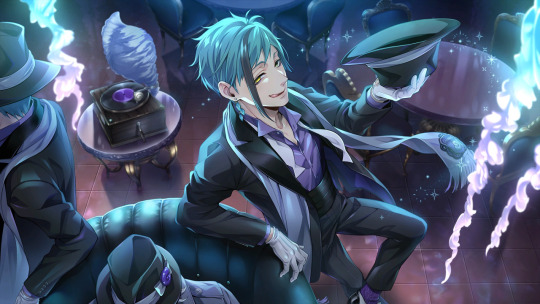
Floyd Leech
Favorite Country/City: He wants to go places where he can do things whenever it strikes him. He would also want to go somewhere with clear water. Thus, I believe he would love to go to Tahiti. There’s a market, he can go scuba diving with whales and sharks, he can go surfing, he can go to the museum, and if he wants to stay in his hotel room then he can.
Favorite Cuisine/Dish: His favorite dish is Takoyaki, so I think it’s safe to assume that he likes Japanese cuisine. However, it is stated that shiitake mushrooms come from mountainous regions in China, Japan, Indonesia, and Taiwan, so he likes any dishes without the mentioned mushrooms.
Favorite Drink: As funny as it is, Sex on the Beach, as it’s a summer drink that he loves to enjoy on the beach. Also, he has the emotional maturity of a 7th grade boy, and the name was hilarious to him.
Favorite Souvenir: Two little figurines of a guy and a girl dancing with each other. They fit together in a way that was complex, making it a puzzle of sorts.
Favorite Singers/Songs: Either Laffy Taffy or Sneaky Link 2.0 are his favorite songs. This man is searching for his Mrs. Bubblegum. He is looking to be somebody’s sneaky link. He lives for drama, and no one can tell me otherwise.
Favorite Movie: The Meg, because who doesn’t love a giant, prehistoric shark that escapes from the gaseous layer at the bottom of the Mariana Trench? He has sharp teeth like the megalodon, and he likes the jumpscare where the shark jumps up.
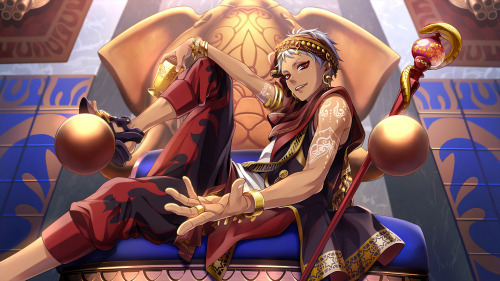
Kalim Al-Asim
Favorite Country/City: He loves tropical areas, but he loved the Bahamas and the capital of Nassau the most. The resort there was great, and the people were very friendly. It was a laid back time, and it was not even a five minute walk to the beach. Plus, coconuts grow there apparently (correct me if I’m wrong), and coconut juice is his favorite food.
Favorite Cuisine/Dish: A lot of Thai food, specifically the desserts, use the flesh of the coconut, so I think I have substantial evidence to say that he does like Thai food. He would be very hesitant to try Thai curry, though… unless he had somebody to try it with him.
Favorite Drink: Piña Colada, doesn’t matter if it’s virgin or not. He loves the song that accompanies it as well. Anyways, the drink is a very fruit-filled drink. He thinks it’s the right amount of sweetness, so he loves to enjoy it.
Favorite Souvenir: A singular photograph, as he somehow found himself involved in a volunteer program and he took a picture with children from one of the villages he was volunteering at.
Favorite Singers/Songs: He also likes songs that remind him of the beach, and I stated that he probably likes the song Escape (The Piña Colada Song), but it’s not his favorite. His favorite song would be Celebration, by Maffio, Farruko, and Akon (feat. Ky-Mani Marley).
Favorite Movie: I have a feeling that he would love the movie Shrek. It’s funny, a lot of memes have been made from all the movies, all the sequels are great. What’s not to love about the movie(s)?
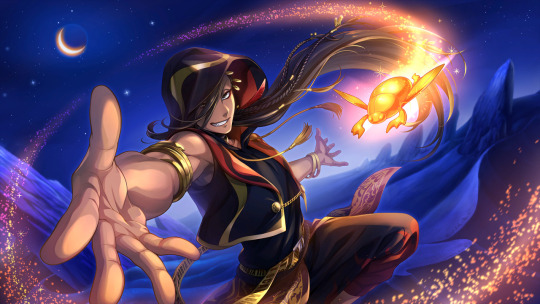
Jamil Viper
Favorite Country/City: He gives me a vibe that I resonate with on the historical front, so I would think he would like to visit somewhere in the Middle East, as that is where ancient Mesopotamia was. Specifically, he would love to visit Ur, in Iraq. Not only is it located in a desert (familiar territory), but it’s one of (if not the) first cities in the world.
Favorite Cuisine/Dish: Unlike Kalim, he loves curry, so that gives me reason to believe that he would enjoy Indian cuisine the most. Syrian food comes in second for him (I spend a lot of time at my friend’s Syrian house and they make good food… I’m hungry now).
Favorite Drink: This was difficult, but I feel like he would move towards margaritas, and not just because of the song. Because curry can be spicy, I would say he likes a spicy margarita as well. His favorite non-alcoholic drink would be a mangonada.
Favorite Souvenir: All the books he picked up to learn different languages. He learned along the way as well, and all of the books have annotations within them so he has them for future reference.
Favorite Singers/Songs: He likes breakdancing, so he likes any song he can breakdance to. I am not very involved within this genre of music, so after doing some research I have come to the conclusion that he would love the song The Witch, by the Bamboos.
Favorite Movie: Footloose, as it’s a movie about dancing and rock music being banned. He saw it because it looked interesting, and he learned the Footloose dance. Also, the song Holdin’ Out For a Hero makes him feel like he wants to be someone’s hero.
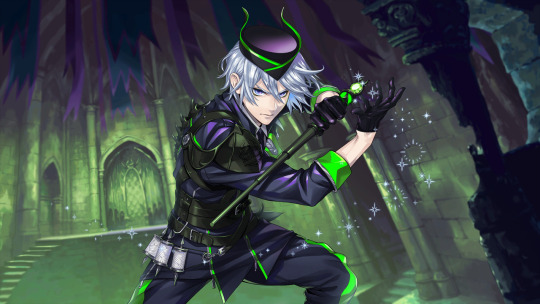
Silver
Favorite Country/City: Carrickfergus, as it holds the Carrickfergus Castle. It may be a Norman castle, but it’s because of the history (and the fact that he may be based off of both the Princess and the Prince and thus deserves a castle {personal opinion}) that he enjoys his time in the town.
Favorite Cuisine/Dish: This is the first time I’ve actually dove into investigating Silver’s likes and dislikes, and apparently he likes mushroom risotto, which is thought to originate from the Italian region of Lombardy.
Favorite Drink: He strikes me as the type to like wine, and not the bitter stuff. He likes sweeter wines, especially white wines as they pair nicely with the risotto he loves.
Favorite Souvenir: A journal, in which he writes about his many journeys around the world.
Favorite Singers/Songs: I think he is a Swiftie. That being said, his favorite song would be Love Story, as he is looking for his Juliet. However, he is not one of those over-excited fans who will tear someone up for saying they don’t like Taylor Swift’s songs. He will just judge them quietly.
Favorite Movie: Gladiator, partially for the plot, partially for Russel Crowe. It reminds him of the training he had to go through as a knight.
#twst#twst x reader#twisted wonderland#disney twisted wonderland#twisted wonderland x reader#disney twst#twst wonderland#twst riddle#riddle rosehearts x reader#riddle rosehearts#riddle x reader#riddle#twst riddle rosehearts x reader#twst riddle rosehearts#twst riddle x reader#twst ruggie#ruggie x reader#ruggie bucchi x reader#ruggie#ruggie bucchi#twst ruggie x reader#twst ruggie bucchi#twst ruggie bucchi x reader#azul ashengrotto x reader#twst azul x reader#twst azul#azul x reader#azul#azul ashengrotto#twst azul ashengrotto x reader
236 notes
·
View notes
Text
A (not exhaustive) inventory of Astyanax's death and survival.
In the Little Iliad, Neoptolemos is the killer.
In the Iliou Persis, Odysseus is the killer.
In the Trojan Women we don't actually know who does the deed, "merely" that Odysseus is singled out as the (major) voice who argued for his death. As Andrew Erskine in Troy Between Greece and Rome points out (referencing another academic as well), given the lack of detail in what's left to us, Odysseus might well have been involved in Astyanax's death in the Little Iliad as well, in the same role he has in here in the Trojan Women.
Seneca (Troades) follows Euripides in the public deliberation and has Odysseus being present for Astyanax's death, but he has Astyanax leap voluntarily. (Excuse me, WTF.)
Quintus of Smyrna, in his Posthomerica, has the killing be done by "the Greeks". Not just the deliberation like in the Trojan Women, but "they" seized him and tossed him from the wall. Whether intended or not, it makes it read a little like a mob scene. (edited to add this, because I'd forgotten to check.)
Tryphiodoros, in the Taking of Ilios, has it again be Odysseus.
So what we get is that even when Odysseus isn't actively the hand that commits the deed, he's the (first? major? leading?) voice in claiming it "needs" to be done. For the ~safety of Greece~, of course.
So, now we come to myths and stories of Astyanax's survival. It's mostly here the "not exhaustive" disclaimer applies. For a lot of the Medieval sources (where this idea flourishes) I can't double check if they say anything about who/how Astyanax survives.
With that said; the Medieval manuscripts aren't the earliest ideas of Astyanax's survival!
One is late Classical or earlier; Dionysios of Halikarnassos reports of the Ilians (that is, the Anatolian Greeks of the "modern" Ilion/Troy, built somewhere after ~1000 BC) had a founding legend that involved Astyanax and Askanios.
Given that Astyanax can approach his cousin after being released by Neoptolemos, presumably Neoptolemos didn't kill Astyanax but rather take him along into slavery with his mother and Helenos.
I'll just include this screencap from Troy Between Greece and Rome for the next bit since it's easier:
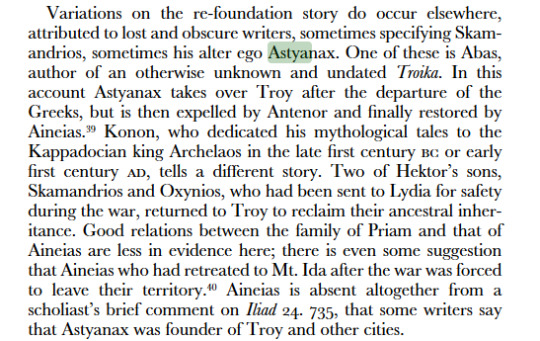
On to the Medieval sources; the absolute earliest appearances of Astyanax here is as the founder of the Franks, now named Francion/Francus. French Wikipedia has a note to an author that says that Astyanax's survival was effected by (unnamed in the text and note) Medieval authors by the Greeks softening up and ending up not killing Asyanax because of his beauty.
Next is the "Andromache swaps Astyanax for another child and the Greeks (more like Odysseus) is tricked and kills the substitute". It has several appearances/uses, but the earliest (at least by the list in Wikipedia) seems to be Boiardo's Orlando Innamorato (1495).
While being unable to, like, check if anyone is named as the rescuer in some of these (Wiki also has an unsourced mention of Talthybios), in general we seem to land on either Neoptolemos or, in later stories, Andromache herself. I wouldn't think Neoptolemos ends up not killing Astyanax out of the goodness of his heart, more as a way to control Andromache, but there it is either way.
Odysseus is only ever an obstacle to be worked around, which isn't odd given how often he is either the killer, or, maybe far more important, the voice to argue that Astyanax need to die. Not so odd he'd then be construed in later stories as the character to be specifically tricked by the child-swap.
I'll put the sources under the cut!
(For the Little Iliad)
Scholiast on Lycophr. Alex., 1268:
"Then the bright son of bold Achilles led the wife of Hector to the hollow ships; but her son he snatched from the bosom of his rich-haired nurse and seized him by the foot and cast him from a tower. So when he had fallen bloody death and hard fate seized on Astyanax. And Neoptolemus chose out Andromache, Hector's well-girded wife, and the chiefs of all the Achaeans gave her to him to hold requiting him with a welcome prize. And he put Aeneas, the famous son of horse-taming Anchises, on board his sea-faring ships, a prize surpassing those of all the Danaans."
(For the Sack of Ilion/Ilioupersis)
The Greeks, after burning the city, sacrifice Polyxena at the tomb of Achilles: Odysseus murders Astyanax; Neoptolemus takes Andromache as his prize, and the remaining spoils are divided.
(Note 136 to Apllodorus' Library, trans. Frazer)
Compare Arctinus, Ilii Persis, summarized by Proclus, in Epicorum Graecorum Fragmenta, ed. G. Kinkel, p. 50; Eur. Tro. 719-739, Eur. Tro. 1133-1135; Eur. And. 8-11; Paus. 10.26.9; Quintus Smyrnaeus, Posthomerica xiii.251-257; Tryphiodorus, Excidium Ilii 644-646; Tzetzes, Scholiast on Lycophron 1263; Scholiast on Eur. Andr. 10; Ov. Met. 13.415-417; Hyginus, Fab. 109; Seneca, Troades 524ff., 1063ff. While ancient writers generally agree that Astyanax was killed by being thrown from a tower at or after the sack of Troy, they differ as to the agent of his death. Arctinus, as reported by Proclus, says merely that he was killed by Ulysses. Tryphiodorus reports that he was hurled by Ulysses from a high tower. On the other hand, Lesches in the Little Iliad said that it was Neoptolemus who snatched Astyanax from his mother's lap and cast him down from the battlements (Tzetzes and Paus. 10.26.9). According to Euripides and Seneca, the murder of the child was not perpetrated in hot blood during the sack of Troy but was deliberately executed after the capture of the city in pursuance of a decree passed by the Greeks in a regular assembly. This seems to have been the version followed by Apollodorus, who apparently regarded the death of Astyanax as a sacrifice, like the slaughter of Polyxena on the grave of Achilles. But the killing of Astyanax was not thus viewed by our other ancient authorities, unless we except Seneca, who describes how Astyanax leaped voluntarily from the wall while Ulysses was reciting the words of the soothsayer Calchas and invoking the cruel gods to attend the rite.
(Trojan Women, Euripides)
Talthybius
You that once were the wife of Hector, bravest of the Phrygians, [710] do not hate me, for I am not a willing messenger. The Danaids and sons of Pelops both command—
Andromache
What is it? your prelude bodes evil news.
[…]
Talthybius
They mean to slay your son; there is my hateful message to you.
Andromache
[720] Oh me! this is worse tidings than my forced marriage.
Talthybius
So spoke Odysseus to the assembled Hellenes, and his word prevails.
Andromache
Oh, once again alas! there is no measure in the woes I bear.
Talthybius
He said they should not rear so brave a father's son.
(Dionysios of Halikarnassos; Ant. Rom. 1. 47. 5–6)
Aineias . . . sent Askanios, the eldest of his sons, with some of the allies, mainly Phrygians, to the land called Daskylitis, where the Askanian lake is, since his son had been invited by the inhabitants to rule over them. Askanios did not dwell there for long. When Skamandrios and the other descendants of Hektor approached him after Neoptolemos had released them from Greece, he went to Troy and restored them to their ancestral kingdom.
54 notes
·
View notes
Text
Ah, midsummer: when we’re getting deeper and deeper into the “ohhh, this is a classic horror novel” stage of Dracula Daily. With my historian hat on, I have just one observation to make about our June 25 entry.
The only thing I found was a great heap of gold in one corner—gold of all kinds, Roman, and British, and Austrian, and Hungarian, and Greek and Turkish money, covered with a film of dust, as though it had lain long in the ground.
Huh, you may be saying to yourselves, that seems like a random assortment of coins. Why Roman and then British and then all the others? Why these coinages, specifically?
Empires. They’re all empires. The British Empire saw itself very specifically as the successor to Rome in the scope of its power and learning (but also with the culture of Greece, because they were, they were convinced, cool like that.) So we have Rome, master of the ancient world as imagined by Victorians. We have Britain, master of the modern world ditto, and it must be said they had a point. Austria and Hungary were, at the time of Jonathan’s writing, a single empire, and had been since 1867, but this was a temporary state of affairs linking two powerful monarchies of East-Central Europe. Greece we’ve covered. And then there is “Turkish money,” the currency of the Ottoman Empire, masters of enormous swathes of Central Asia and Southeastern Europe from the 15th century onward.
And all of this money? All of this power? The “chains and ornaments,” still more obvious signifiers of power? All of this is much more relevant to how the Count lives than furniture. And it tells us not only about his past, but, by implication, about his future ambitions. Dun dun dunnnnnn.
#dracula daily#dracula#COFFIN REVEAL CHAPTER#i had forgotten how deeply creepy all of this is#and how clearly dracula wants to -- uh -- establish a vampire empire#apparently#bram stoker
2K notes
·
View notes
Note
Hey do you have any literature recommendations for people who want to broaden their knowledge on the classics and Greek/Roman myths without taking university courses?
So like for people (such as myself) who have read Bullfinch's Myths of Greece and Rome and Edith Hamilton's Mythology: Timeless Tales of Gods and Heroes but want to deepen their knowledge and maybe go to intermediate level type stuff. Or whatever the level above the mentioned literature is.
Well those two books are quite old and skip over quite a few things. Both are very important to our culture, historically, but I'd recommend reading through some more modern popular retellings like Stephen Fry's Mythos series if you're looking for pure entertainment and a dummy's guide to Greek myths.
The Penguin Dictionary of Classical Mythology is a useful reference book if you have difficulty keeping track of all these names and whatnot. It's just a reference book but you know. Having a reference book handy is quite useful. I personally prefer reference books when it comes to checking stuff when I'm doing mythology things anyways. They're generally more organized than the internet.
If you're looking for entertaining retellings of less popular myths, I'd actually recommend going to videos and podcasts for that. YouTubers like MonarchsFactory, Overly Sarcastic Productions, Jake Doubleyoo, and Mythology & Fiction Explained are all people who do a lot of research themselves on the myths they retell and I would recommend all of them to basically anybody. As far as podcasts go, Mythology & Fiction Explained has a podcast version and Let's Talk About Myths, Baby! is a very informative podcast that talks about sources for the myths and has interviews with experts on the subjects. It's also a podcast that is specifically Greco-Roman based.
As far as doing slightly more in-depth research, I cannot recommend theoi.com enough. I really can't. It has overviews of the most common myths, it has pages about god and hero cults, it cites it's sources and has an online library of translated texts. It's just really good. Go clicking around it for a while. It's a lot of fun if you're into that sort of thing.
As far as primary sources for myths go, there's a few places you could start. The Iliad, perhaps. The most recent English translation is by Caroline Alexander but I personally prefer Stanley Lombardo's translation. The Odyssey is a more accessible read in my opinion if you're not used to reading epic poetry. Emily Wilson's translation is especially accessible, written in iambic pentameter and generally replicating Homer's simple conversational language.
The third traditional entrance into the epic cycle of the surviving literature is the Aeneid. The newest translation of that is by Shadi Bartsch, which is pretty good, but it reads more like prose than poetry. Would still highly recommend it though. Robert Fitzgerald's translation is also good.
If you wanna get fancy you can read the Post-Homerica which attempts to bridge the gap between the Iliad and the Odyssey. It's not often read but it's one of the latest pagan sources we have from people who still practiced ancient Greek religion.
If you want a collection of short stories from ancient times, Ovid's your guy. Metamorphosis is specifically Roman and specifically Ovid's fanfiction, but it's also a valid primary resource and Ovid generally views women as people. What a concept!
Though I think the absolute best overview from ancient times itself is The Library aka Biblioteca by pseudo-apollodorus. Doesn't matter what translation you get. The prose is simple to the point where it's difficult to screw it up. Not artistic at all. It is, quite simply, a guy from ancient times trying to write down the mythological history of the world as he knew it. It has a bunch of summaries of myths in it, and most modern printings also have a table of contents so you can essentially use it as a reference book or a cheat sheet. I love it.
The Homeric Hymns weren't actually written by Homer but that's what they're called anyways. They're a lovely bit of poetry because, well, they were originally hymns. They've got some of the earliest full tellings of the Hades and Persephone story and the birth of Hermes in them. They also provide an insight into how ancient people who were most devoted to these gods viewed them. Go read the Homeric Hymns. They're lovely. You can buy the Michael Crudden translation or you can read a public domain translation online. I don't care. Just read them.
If you're into tedious lists, the next place I'd recommend you go after you read all the fun stuff is Hesiod's Theogony. Hesiod, the red pill douchebag of the ancient world, decided he was gonna write down the genealogy of all the Greek gods. That means lists. I'm not exaggerating. Be prepared for a lot of lists. But this work also has the earliest and one of the most complete versions of the story of Pandora, the creation of humans, and the most popular version of the Greek creation myth. So, it's very useful. If you can take all the lists.
The Argonautica aka the voyage of the argo by Apollonius of Rhodes, is also here. That is also a thing you can read. About the golden fleece and whatnot. And Jason. You know Jason. We all hate Jason.
Greek theatre also provides a good overview of specific myths. The three theben plays, Medea, the Bacche, etc. We've only got thirty-something surviving plays in their entirety so like... look up the list. Find one that looks interesting. Read it. Find a performance of it online, maybe. They're good.
If you want to dive into the mythology as a religion that was practiced, Greek Religion by Walter Burkurt and Ancient Greek Cults: A Guide by Jennifer Larson are pretty good books on the topic and often used as textbooks in college courses.
If you wanna get meta and get a feel for what the general public today thinks about Greek myths and what the average person that's sort of knowledgeable about Greek myths knows, the books you already mentioned are good. That's what people usually read. In addition to those, most people's intro to Greek myths generally involves The Complete World of Greek Mythology by Richard Buxton, D’Aulaires’ Book of Greek Myths by Ingri and Edgar Parin d’Aulaire, or The Percy Jackson series.
I've been flipping through the big stacks of mythology books I keep on my table trying to remember if I've forgotten anything but I don't think I have so, yeah. Hope this helps. There's no correct starting point here. Once you get started there's a nearly endless void of complications and scholarship you can fall down that you'll never reach the bottom of. This post is basically just a guide to the tip of the iceberg.
#mythology#greek mythology#roman mythology#reference#roman said a thing#classical mythology#classics#classics reference#mythology for beginners#mythology reference#greco-roman
384 notes
·
View notes
Text
Folklore Fact - Gryphons/Griffins
Gryphons, griffins, griffons, however you prefer to spell it (I personally use gryphon) - let's talk their folklore and mythology!

(Attic pottery depicting a satyr and a griffin and an Arimaspus from around 375-350 BC, Eretria.)
You probably already know the common popular culture concept of a gryphon: a big, vicious beast that attacks people and probably eats them and/or carries people away to its nest to feed them to its babies. Not much about it has changed in legend, though in a lot of popular culture today, it has seemed to lose its divinity. Gryphons - griffins, whatever you prefer - have quite the robust history, like so many creatures of myth and folklore. Unlike some, however, they have changed very little over time.
Note that this article a general overview of concepts, not a detailed history.
Let's start with etymology, because I just love that stuff. The word "griffin" comes from the Greek word "gryps," which referred to a dragon or griffin and literally meant "curved [or] hook-nosed." Late Latin spelled it "gryphus," a misspelling of grypus, a Latinized version of the Greek (source: https://www.etymonline.com/, one of my favorite websites).
Griffins are said to have the head and wings of an eagle and body of a lion. They may or may not also have pointed ears, depending on the depiction (they more often did, overall, though the griffin of Crete is a notable exception). They were said to guard the gold in the mountains of the north, specifically the mountains of Scythia. The one-eyed Arimaspian people rode on horseback and attempted to steal the griffins' gold, causing griffins to nurture a deep hatred of and hostility toward horses.
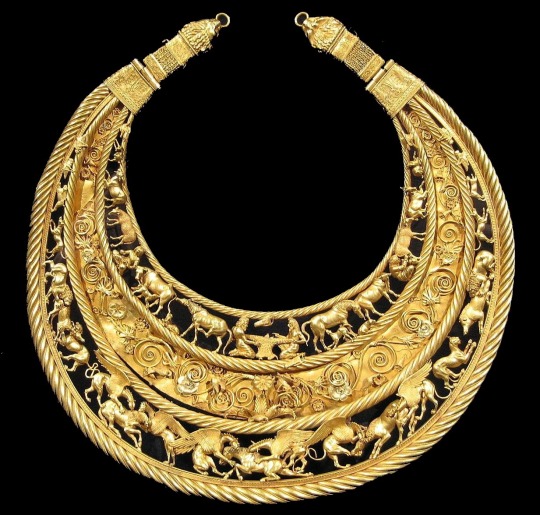
A Scythian pectoral, thought to have been made in Greece, depicting - among other things - griffins slaughtering horses. Griffins really, really hate horses.

The famous griffin in the palace of Knossos at Crete, from the Bronze Age (restored).
Griffins appear in truly ancient civilizations, not only Greece but also ancient Egypt and civilizations to the east, including ancient Sumeria. Griffins were later said to also dwell in India and guard gold in that region, and they continued to appear in art throughout ancient Persia, Rome, Byzantium, and into the Middle Ages throughout other regions such as France; they were depicted in ancient Greece with relative frequency and occasionally of considerable importance.
Griffins appeared in many ancient Greek writings, including Aristeas in the 7th century BC. Herodotus and Aeschylus preserved and continued these writings in the 5th century BC, including lines such as,
"But in the north of Europe there is by far the most gold. In this matter again I cannot say with assurance how the gold is produced, but it is said that one-eyed men called Arimaspoi (Arimaspians) steal it from Grypes (Griffins). The most outlying lands, though, as they enclose and wholly surround all the rest of the world, are likely to have those things which we think the finest and the rarest." Herodotus, Histories 3. 116. 1 (trans. Godley) (Greek historian C5th B.C.), source: https://www.theoi.com/Thaumasios/Grypes.html (a wonderful site)
Physical descriptions of the griffin were not commonplace until some later works, and even then, their appearance wasn't always agreed upon. Even the notion of griffins having wings was sometimes disputed. Some scholars even got pretty wild, claiming griffons had no wings at all but instead skin-flaps that they used to glide. They apparently hated awesome things, so it turns out there were always boring people who thought they knew everything, wanted to explain everything "logically," and generally assume they were the smartest ever while also ruining mystique. They would make great scientists today.
Griffins were, however, often said to be holy in nature. They were referred to as the "unbarking hounds of Zeus" by Aeschylus, who warned others never to approach them. Gryphons were also considered sacred to several gods, including prominently Apollo, who was said to depart Delphi each winter, flying on a griffon (griffin, gryphon, etc, I keep swapping this around, I know; my brain spells it differently because I've read way too many sources), and he also is occasionally depicted as hitching griffins to his chariot in addition to riding one. This was particularly prominent in the cults of Hyperborean Apollo, one of the many endless and fascinating cults of ancient Greece.

Medieval bestiary depiction of a griffin slaughtering a horse.
Even by the Middle Ages, gryphons still hated and slaughtered horses and guarded gold, elements that certainly persisted throughout their legends. They also killed men and carried them away to their nests, similar to the manner in which Aeschylus warned people to stay away from gryphons even back when. We can obviously assume griffons were never cuddly, so that isn't much of a change.
Griffins also did not entirely lose their divine relations even into the Middle Ages. Christianity often used positive portrayals of griffins to represent and uphold certain positive tenets of Christian faith; likewise, they became important symbols of medieval heraldry, used to represent a Christian symbol of divine power, as well as general courage, strength, and leadership, especially in a military sense. The depiction of the griffin as a powerful and majestic creature - killing horses and men or not - throughout its history is no doubt because they are a combination of two beasts often considered noble symbols of bravery, power, and divinity: the lion and the eagle, kings of land animals and birds, respectively.
That's a general overview! As you can see, griffins aren't always so bad, at least not compared to some of the other creatures out there from folklore and myth.
( If you like my blog, be sure to follow me here and sign up for my free newsletter for more folklore and fiction, including books!
Free Newsletter - maverickwerewolf.com (info + book shop) — Patreon — Wulfgard — Werewolf Fact Masterlist — Twitter — Vampire Fact Masterlist — Amazon Author page )
#folklore#mythology#gryphon#griffin#fantasy creature#gryphons#griffins#griffon#folklore fact#folklore thursday#greek myth#myth#persian myth#medival#medieval folklore#history
46 notes
·
View notes
Text
One of the reasons I started reading Roman Homosexuality was to get a better idea of how accurate the attitudes toward homosexuality are in Colleen McCullough's Masters of Rome series. She seems to have gotten some things wrong, mainly by portraying homosexuality as more accepted in Greece than in Rome. She also got some things right, like the Romans stereotyping Greeks as "soft" and over-attached to luxury.
This has major implications for Sulla's character arc. In real life he wouldn't had had to conceal his relationship with Metrobius, as he does in the books. Her Roman protagonists also tend to view eastern rulers as effeminate and homosexual, but in real life the stereotype would've been closer to "sybaritic" or "oversexed," not gay/bi specifically. Also, gay men in Masters of Rome are usually portrayed as effeminate (with the possible exceptions of Sulla and Atticus). But the real Romans were quite aware of more "macho" gays - most famously the emperor Otho, who preferred older men.
All that being said: McCullough's books started coming out in 1990. Roman Homosexuality, by Craig Williams, was published in 2010. McCullough did a lot of research, but I don't know how much of the characters' portrayals are her own biases, and how much are her attempt to match the scholarship available to her at the time she wrote. Unfortunately, her portrayal of homosexuality doesn't improve much from the first book to the last (in 2007), so whatever her intentions, I don't think she kept up with the current research...
I also have to reiterate that she accidentally wrote Octavian and Agrippa as a couple. You can find multiple passages in The October Horse and Antony and Cleopatra where McCullough clearly realized "...this sounds gay," tried to no-homo it, and it only sounded gayer. She added Octavian falling in love with Livia. Nope, still gay, and now it's a polycule! I can't even be mad at her for it, because the result is really, really funny.
Anyway. The moral of the story is: if you're a writer, then even if you have no intention of writing queer romance, I highly recommend reading a book or two in the genre, or else you may pull a McCullough and write a queer romance by accident. Which is not a problem, I love queer romance. But you'd probably prefer to communicate platonic or romantic relationships intentionally to your readers, yes? Besides, it'll help you avoid writing stereotypes like she did.
(I'm still less than halfway through Williams' book. Might revise or add to this post later.)
#jlrrt reads#roman homosexuality#craig williams#colleen mccullough#masters of rome#those books didn't originate my octagrippa agenda but they absolutely fed it#homophobia mention#jlrrt essays
59 notes
·
View notes
Note
I just had an idea and i have to note it down, so why not come to your overstuffed inbox to do it? 😆
The setting would be ancient greece, or rome or something.
Morpheus is the son of a noble and has had athe best education available, and has become an renowned painter and sculptor. Only the richest people and institutions can afford to commission him, and his workshop is filled with servants and helpers to sweep the dust and chips away as he chisels the marble slabs into shape, to wait on him with wine and fruit, to fan him as he's working on his creations.
One day as he's sketching iut a bust of a god for a temple he's do frustrated, because the proportions just aren't right. He gets so angry that he throws his glass goblet against the wall, and then a servant runs to clea up his mess, the servant's tunic slips a bit to the side as he's bowing down and - by the gods, those hipbones are exquisit!?
Before he knows what he's doing he's crowding the servant against the wall, plasters his body against the strangers' back to feel out all of the secrets hidden underneath the dirty blue toga. The servant gives a throaty moan and lets him do as he pleases, clearly excited and turned on by being manhandled and ordered around.
Morpheus starts muttering about a perfect ratio, a beautiful specimen, a god turned into flesh etc, and lets his hands trail over Hob's shoulders, back, hips, arse and then kneels down behind him to trace his muscular hairy legs. Hob's ass is now at Dream's eye level, and how could he resist? He lets his hands glide up the legs, slip underneath the hem of the fabric to reveal the lily white skin of the servant boy's arsecheeks. To his freat delight Hob cants his ass back and widens his stance, clearly proud of his body and very into being worshipped.
Other servants and workers pass by them, they're by no means alone, but they might as well be - Lord Morpheus on his knees, his face struck with wonder, inches away from a servant's asshole, exposing him to the world to see and yet, only there to please his Lordship.
Neither of them could say how long they stood there, but when Hob breathes out a desperate 'Please, Sir..' he can barely breathe in before he has two slender fingers slicked with oil up his hole, pumping in and out and he's already leaking before the first brush of them grazes his prostate.
Yeah.
That's all I can muster up right now.
Love ya!
Ajsjjdjfj hello my dear! So nice to hear from you!
I'm absolutely LOVING this whole concept. Morpheus being the precocious, temperamental artist is a wonderful image. He's got this whole studio of students and assistants but he insists on doing 90% of the work by himself because he's such a perfectionist. And although he's had one or two muses to inspire him throughout his career, he's struggling with this latest project. It just isn't working out the way he wants.
And Hob (who specifically got a servant's job in Morpheus’s studio because he's totally in awe of him) just so happens to be the inspiration that's been missing. He isn't what Morpheus would call pretty, but he's got the raw sex appeal that he suddenly realises that this particular sculpture requires. Hob is perfectly imperfect, and Morpheus feels like he's been hit with a bolt of lightning.
The work of the studio goes on as usual, while Morpheus divests Hob of his robe entirely and bends him into all kinds of positions and contortions. Hob is wonderfully flexible and quite content to bend over with his arse exposed while Morpheus studies his musculature with trembling hands. His thighs, his feet, his hips and waist are all caressed or massaged by the artist's fingers like he's trying to commit Hob’s entire anatomy to memory.
Of course, Morpheus couldn't see Hob’s cock when he first set eyes on him... but he isn't disappointed. If anything he's even more sure that Hob should serve as the model for the entire sculpture. Fully nude, he will be the most wonderful image of a god that Morpheus has ever captured. As his fingers wrap greedily around Hob’s shaft and heft at his balls he begins to begins to smile for the first time in many months.
Hob has been so patient - he was clearly born to be a model. He follows every order quickly and without complaining. Every so often he makes a cute little noise that simply makes him even more endearing. He obviously deserves a reward for all that he's given to Morpheus already.
His body seems ever more godly and delightful as he squirms and twitches. His little pink hole is perfectly tight, and he's so responsive to every little flex of Morpheus’s fingers inside him. As he whines and whimpers and fucks himself eagerly on his lord's fingers, Morpheus can't help but think of all the erotic things he wants make Hob do. All for the sake of art, of course. A man who looks so absolutely divine when he cums shouldn't be hidden away for only Morpheus’s enjoyment.
From then on, Hob is hardly allowed to leave Morpheus’s side. Even when there's no work being done on the sculpture, Hob dutifully follows Morpheus wherever he has to go. He even sleeps by him at night. You never know when inspiration might strike! What better way to study the beauty of man, than to have him wanton and writhing in your bed?
86 notes
·
View notes
Text

Demo | Forum
You are a high school student passionate about writing interactive fiction novels. Grammar, story structure, character design, and story design are foreign concepts to you, but that won’t slow you down because you have passion and the power of friendship on your side. A tragic accident sends you into a coma, transporting you into the world you have created.
Explore a world filled with bugs, excessive stats that cancel each other out, and ambiguous choices. Romance one-dimensional characters, overcome poorly designed challenges to escape the hell you’ve created, and become the Strongest Writer!

The game is primarily narratively driven, even though there will be silly challenges sprinkled here and there. Some random elements are present, but they won’t stonewall your progress. You will never be forced to replay an encounter because you had a bad die roll. Ridiculously difficult or poorly worded mini-games will pop up here and there. But the ones that have “correct” solutions are accompanied by a skip button that can be used without any punishment.
You will have a mobile base of operations, a castle that can fit in your pocket, where you can grow plants, make potions, train with your companions and decorate your rooms. After you reach a certain point in the game, time will advance when you complete quests, making the plants grow. The plants can be used for brewing potions that will add more flavor to future encounters but aren’t a prerequisite for progress.
At the end of each chapter, you will enter a dream-like state where you can communicate with the Real World via a powerful artifact. However, the communication is limited to sending updates to the game you’re trapped in and reading the player’s feedback on the forum.
After the first part of the game, you will get to have a say on how the Empire grows over the course of the story by voting on policies. These policies will get enacted if you and your crew complete quests that will sway the citizens in your favor. You will be free to tackle specific issues from a progressive or conservative lens without having the game punish you for making the wrong choice. Scratch that. Whatever you choose will have catastrophic consequences on the Empire but in different ways. By the end of the story, the Empire will be in crisis.

The game is split into three parts: Escape from the Underworld, Rise of the Empire, and Fall of the Empire. In the first part, you will escape the Underworld, the hell of your fictive world, with the aid of your fully customizable romanceable companion, Olympia/Olympus. You will gather a party of virtuous souls and traverse the Great Barrier into the surface world. Upon escaping the Underworld and entering the MC’s fictional world, the “Real” World, you and your companions become Immortals, overseeing the fate of the Empire for centuries to come.
At the time of writing the story, the MC was sick of all the medieval fantasy stories that resort to misogyny for the sake of realism, so they wrote an “inclusive” setting that “solves” inequality issues only on a surface, superficial level. The Empire is a mishmash of Ancient Rome and Ancient Greece under constant assault by progressive barbarian hordes who enslave and torture citizens equally, regardless of gender, race, or sexual orientation. Political decisions in the Empire are ultimately made by a supreme ruler, Caesar, but every citizen has a right to express their grievances and opinions in the Forum (an actual roman style forum, not an online one).
As generations pass, you and the Immortals will oversee the Empire grow from antiquity to a steam-punk future near its decline.

Olympus/Olympia
age: unknown/ timeless
race: unknown
gender: player selectable
appearance: custom
Olympia/Olympus is the first immortal that the MC encounters in the Underworld. The self-proclaimed soul mate of the main character, Olympia/Olympus, is the primary romantic option for the player. Kind-hearted, straightforward, overpowered, and with a non-existent sense of personal space, Oly will accompany the MC almost everywhere. The only times when you will be apart is when you have to do challenges alone.
Bellona
age: 27
race: human
gender: female
appearance: average height, athletic build, olive skin, brown eyes, long brown hair in a high ponytail.
Bellona is one of the finest warriors of the Empire, who knew no equal on the battlefield until she found her end at the Kālá’s hand, whom she managed to take down with her to the Underworld. Abandoned at a young age by her parents, she had to learn to fend for herself and develop a can-do attitude that no one rivals. Impulsive by nature, she has no regard for diplomacy - her creative swear words are common in any heated discussion. The one thing she hates more than whining and weakness is others picking on her friends, even for the most trivial things.
Athena
age: 30
race: human
gender: female
appearance: tall, slim build, fair skin, green eyes, undercut, blonde hair.
Athema is a scholar, politician, and equal rights activist. She died at a banquet where a political adversary poisoned her wine cup. Outspoken and articulate, her opinions have sown the seeds of critical thinking within the Empire, prompting a vocal minority to question whether the Empire will be remembered as a bastion of enlightenment in history or a shameful asterisk. Competent in rhetorical debates, she never backs down from a winning argument, even if it means losing political currency. Although she stands her ground firmly in intellectual standoffs, physical confrontations are a no-go for her, looking for cover at the first sign of danger.
Hera
age: 22
race: human
gender: female
appearance: petite, light skin, heterochromia eyes (blue and green), braided, black hair.
Hera is a quiet, reserved young woman whose life ended in mysterious circumstances. She does not remember how she died or does not want to tell anybody. Although she does not enjoy getting involved in politics too much, she is convinced that the best way to organize society is through clearly defined gender roles. Family is the most important thing to her, and she hopes that she will be able to start one as soon as possible. Her cooking and organizing skills are unmatched, which is why she was often employed by wealthy nobles to host their lavish banquettes.
Vulcan
age: 46
race: human
gender: male
appearance: burly, gray hair, groomed silver beard, dark skin
A respected inventor, this reclusive self-reliant man found his end at the hand of an ambitious experiment to replicate the sun in his forge. Even though he feels more at home with his inventions than with people, he is kind and gentle despite losing his temper from time to time. Vulcan will be the main driving force behind the rapid technological advances that the Empire will go through during the game, and you will have a say in what innovations take priority.
Plutus
age: 33
race: human
gender: male
appearance: tall, thin, blond messy hair
This neurotic treasurer got on the wrong side of a knife after uncovering a circle of corrupt aristocrats who were siphoning gold out of the treasury. His obsessive compulsion to account for every penny spent makes him an excellent financial advisor for your team. His expertise will be invaluable in growing the Empire over the centuries.
Kālá
age: unknown
race: unknown
gender: unknown
appearance: short legs, wide hips, elongated torso with thin, long arms, large hands. Dark skin, black eyes, bald. Wears extravagant clothes.
Little is known about them besides their affiliation with the Barbarian hordes and unorthodox fighting style. Before the encounter with Bellona, Kala was undefeated in combat. Has the role of the main antagonist of the story.

Olympia/ Olympus will be the only RO with which you can have a meaningful, long-term romantic relationship. There will be the possibility of having flings with minor, episodic, one-dimensional characters. But you will not be able to be in a relationship with other immortals (but that does not mean you can’t try). As far as the attraction to Oly is concerned, you have multiple options: regular attraction, no attraction, “platonic” attraction, “asexual” attraction, too much attraction, and attraction once you get to know each other better. There will be no explicit sex scenes, but you can expect bizarre scenes that kind of resemble it.
#interactive fiction#hosted games#choicescript#cyoa#satire#social commentary#comedy#wip#hg#choice of games#interactive novel#tsw#the strongest writer
180 notes
·
View notes
Note
I am using the speakly app for spanish and so far i really love it, however some sentences shown confuse me. “tengo una gran familia” and “Eso es una buena idea” confuse me why the adjective is before the noun. Can you explain or link to some answers regarding this? Thank you!
Here's a more comprehensive list of the ones you're talking about
The majority of adjectives go after the noun. These are two of the exceptions and there are a handful of exceptions to the rule
Some of them change meaning:
Tengo una gran familia. = I have a great family.
Tengo una familia grande. = I have a big family.
gran is from grande but it comes out as "grand" or "great" as gran in front of the noun; behind the noun grande means "big" or "large"
You'll see things like es una gran mujer "she's a great woman" rather than es una mujer grande "she's a large woman"
You'll also see it with some monuments like la Gran Muralla China is "the Great Wall of China"
...
With bueno/a "good" and malo/a "bad" it depends. Generally if it's in front it means "good" and "bad" like overall quality; if it's in back it tends to be personality - "kind/good" and "unkind/mean"
Es un buen hombre. = He's a good man. [or, "he is a good man overall"]
Es un hombre bueno. = He's a nice man.
Es un mal hombre. = He's a bad man. [like "he is bad overall"]
Es un hombre malo. = He's a mean man. / He's a bad man.
They kind of get used interchangeably by people but the distinction is something like: buen hombre is like "as a man he is good"... while hombre bueno is "a man who is good/kind".
In front it's a description of how well they fit that noun; buen jefe/buena jefa is someone who is good at being a boss. But jefe bueno/jefa buena is more a comment on their personality
-
Other common ones you'll see:
viejo/a = long-time / old
Es un viejo amigo. = He's an old friend. / He's a long-time friend.
Es un amigo viejo. = He's an elderly friend. / He's a friend who is old.
mismo/a = same / self
Es la misma cosa. = It's the same thing.
Es la cosa misma. = It's the thing itself.
La misma mujer... = The same woman...
La mujer misma... = The woman herself...
propio/a = own / appropriate
Generally if it's in front it typically means "one's own" or "belonging to" like con mi propio dinero "with my own money"; propio/a can also be apropiado/a as "proper" or "appropriate" usually treated as a normal adjective
...
There's also triste and pobre meaning "sad" and "poor"
Ese triste día... = This unfortunate day...
La pobre chica... = The poor/unfortunate girl...
When in front they take on more of a meaning of "unfortunate" or "regretful" or "awful".
In back, they're normal like la chica triste "the sad girl" or la chica pobre which is "the girl who is poor". Like English "poor" could be "unfortunate" [in front] or "in poverty/poor" [in back], where la chica pobre is a comment on her wealth
-
Another important one is antiguo/a
When it's in front it usually means "former" [mi antiguo jefe / mi antigua jefa "my former boss"]... or it means "ancient"
If it's in back, antiguo/a tends to be "old" or "antique"
But especially in history, antiguo/a will come before the noun:
La Antigua Grecia = Ancient Greece
La Antigua Roma = Ancient Rome
El Antiguo Imperio Romano = Ancient Roman Empire
El Antiguo Egipto = Ancient Egypt
La Antigua China = Ancient China
La Antigua Mesopotamia = Ancient Mesopotamia
La Antigua Babilonia = Ancient Babylon
El Antiguo Japón = Ancient Japan
El Antiguo Imperio Maya = The Ancient Maya Empire
...and so on; for people it's the same thing like los antiguos romanos "the Ancient Romans" or los antiguos griegos "the Ancient Greeks" etc etc... or if you're specifically talking about women you might say las antiguas romanas "Ancient Roman women"
42 notes
·
View notes